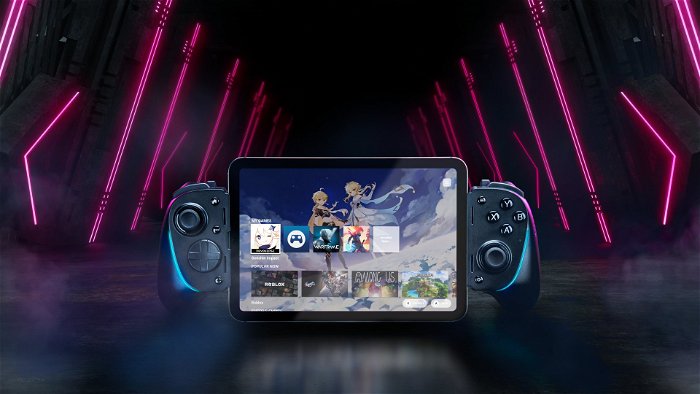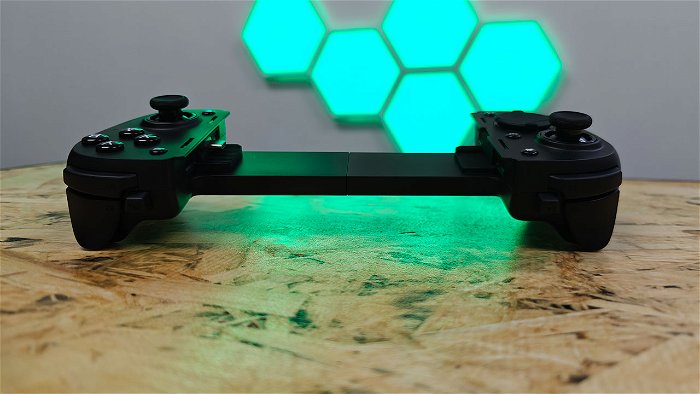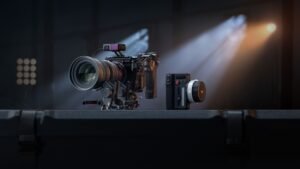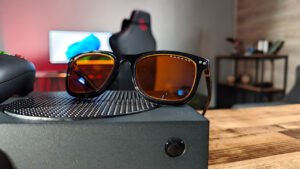The Razer Kishi was my first experience with mobile controllers, and it helped set the bar for all the others I’ve reviewed since. So, it’s fitting that 3.5 years later, the Razer Kishi Ultra has come full circle to potentially take the crown.
The original Kishi was a fine controller, though it left me wanting for stability and security; not that my iPhone ever tumbled out of its grip, but it felt flimsier than I’d prefer, like a Switch if the Joy-Cons weren’t on rails. Several competitors offered similar experiences, from other grip-type controllers where the phone slides into the controller to Bluetooth controllers with vice-like phone holders appended. Ultimately it was the Backbone One that has been my go-to mobile controller of choice… until now.

The Razer Kishi Ultra escalates the product line’s form factor with proper controller handles and a sturdy spine—a huge improvement over the original iteration. Pairs of specialized rubber grips can be inserted into both ends to help support your particular phone model. With the right fit, the phone feels totally secure unless you separate the controller’s halves.
In this department, there’s a nice bonus: many models of phones will be able to fit in the controller without being removed from their original cases. It depends on the phone and the case, but I was able to use the controller with an iPhone 15 Pro, which is still in the standard silicone case from Apple after fiddling with the foam inserts again.
One of the most ergonomically comfortable experiences I’ve had with a controller to-date, the Razer Kishi Ultra feels like a true console-quality gamepad.
Now, naturally, adding proper controller handles does make the Razer Kishi Ultra a little bulkier than most mobile controllers. Portability can be a very important factor when it comes to mobile controllers, and for some consumers, I could see the difference as a potential deal-breaker. Sometimes, maximizing the space in your backpack or carry-on is absolutely critical, and extra protrusions on a controller could be an obstacle.

However, Razer’s design team has somehow managed to make the handles large enough for adult hands yet not so large that they massively distort the phone’s profile. Laid on a flat surface, the Kishi Ultra stands no taller than a PS4’s DualShock controller. About 1/3 of its height off the table is the phone’s size, another third is the telescoping spine of the device, and the lower third is the bottom of the handles and the triggers.
All told, from the table to the top of the thumbsticks, it’s about twice as tall as the Backbone One… but it doesn’t feel it. It wasn’t until I put the devices side-by-side that the difference became apparent.
(Another small design win: you can actually set the device down mid-session and not worry that it’s going to flip. I’ve come to appreciate mobile controllers that let me be interrupted without feeling like I’m putting my phone in jeopardy by setting it aside momentarily.)

Razer packed a couple of extra buttons into the mix as well. The shortcut button below the right stick quickly brings up the Razer Nexus app, which allows user to customize the controller’s features or launch games. The Home button on the top left similarly defaults to GameCenter on iOS to quickly check achievements, and the screenshot button below it is a helpful alternative to the usual side-button method on iPhones. Each side has an additional L4/R4 shoulder button which can be customized, but not necessarily to more advanced combinations or macros.
“The Razer Kishi Ultra will be a strong option for those who have recently upgraded away from Apple’s proprietary Lightning connection with the iPhone 15 family.”
This additional size enables one of the most ergonomically comfortable experiences I’ve had with a controller to-date. The Razer Kishi Ultra feels like a true console-quality gamepad, not just because of its paddles but because of its responsive inputs. All of the face buttons and various triggers and bumpers, even down to the joysticks’ clickable L3/R3 buttons, offer the sort of tactile feedback that helps you know you’re hitting your inputs right. My only sore spot in this regard is that the D-pad’s clicks are louder than I’d like, with a palpable clicking.
Then, since Razer loves a literal glow-up, there are subtle RGBs built into the Razer Kishi Ultra—a light strip up the edge on either side, almost comparable to the light along a DualSense’s touch pad. The Nexus app can program a considerable amount of customization into this display (or turn it right off if you don’t want to make a light show on the bus).

With a USB-C connection, the Razer Kishi Ultra will be a strong option for those who have recently upgraded away from Apple’s proprietary Lightning connection with the iPhone 15 family. It may even entice owners of the latest generation of iPad Minis, as the Razer Kishi Ultra officially supports the smaller tablets. It already approaches PlayStation Portal-esque dimensions with just an iPhone 15 inserted, and the leap to an iPad Mini would make it even larger.
The Razer Kishi Ultra performed flawlessly with everything I threw at it, from remote play via Steam or PS5, to Apple Arcade games, to native iOS versions of some favorite retro titles. It supports haptic feedback, but unfortunately, the selection of titles that utilize this feature is limited at the time of publication. Paired with the Virtual Controller introduced in the Nexus app last year, the Ultra will remain future-proof for a long time.
All told, I think I’m a convert now. Even if portability is absolutely paramount for you, I’d still recommend giving the Razer Kishi Ultra a serious look. Razer’s prodigal controller has edged out the competition with a home console-worthy experience with a secure and ergonomic, yet still light and travel-savvy controller. Anyone who invests a significant amount of time in a week to playing games on their phone should consider taking one for a spin.






